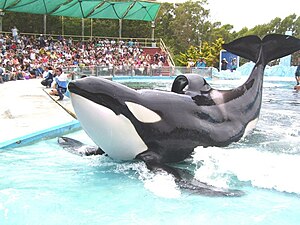Kshamenk - orca: Difference between revisions
No edit summary |
No edit summary |
||
| Line 43: | Line 43: | ||
[[Category:Argentina]] | [[Category:Argentina]] | ||
[[Category:Captive orcas - living]] | [[Category:Captive orcas - living]] | ||
[[Category:1992]] | |||
Latest revision as of 17:07, 23 July 2023
 | |
| Sex | Male |
|---|---|
| Captive at | Mundo Marino, Argentina |
| Captured at | Samborombón Bay, Argentina |
| Capture date | September 9, 1992 |
Kshamenk is a male orca who currently lives at Mundo Marino, an amusement park in Buenos Aires, Argentina. According to Mundo Marino, Kshamenk was found stranded on a beach along with three other orcas in 1992. By the time the fishermen returned with help, the three other orcas had returned to the ocean. But Kshamenk was seriously dehydrated, unable to move, and in critical condition. A team organized by Mundo Marino was able to rescue him, bring him to their medical pool, and restore him to health over a period of months.[1]
However, animal protection organizations are skeptical of this story and suggest that Kshamenk may have been forced ashore by people with an interest in circumventing Argentine laws against the commercial capture of wild marine mammals.[1] Kshamenk is now the only orca living at Mundo Marino.[2]
Capture
On September 9, 1992, two young male Orca were taken captive in Samborombón Bay, Argentina. Although it was reported that the two males stranded on their own, there is a widespread belief that capture crews forced them to strand.[3]
The first male was named Kshamenk, while the larger male was nicknamed "Father of Kshamenk" due to his size, but it is uncertain if he was truly Kshamenk's father. Tragically, "Father of Kshamenk" died on the same day of their capture due to unknown causes.[3]
Life in captivity
Kshamenk, however, managed to survive and was later introduced to a female named Belén, who was caught in 1988. The two formed a close bond and performed together daily. As they reached sexual maturity, they mated, and Belén became pregnant with her first calf. Unfortunately, in February 1998, she gave birth to a stillborn calf.
In the following year, Belén became pregnant again, this time by Kshamenk. However, in February 2000, she died during the fourth month of her pregnancy, and the cause of her death remains unknown.[3]
After Belén's death, Kshamenk had only smaller species of dolphins for companionship, notably a young female, called Floppy.
Six Flags Marine World in Vallejo, California, made several attempts to relocate Kshamenk to the U.S. to live with their lone female Orca, Shouka, but these attempts were denied. Legally, Mundo Marino does not own Kshamenk; he is held in trust by Mundo Marino for the people of Argentina, which means he cannot be sold or considered as their property. Furthermore, Argentine law prohibits the export of live native wildlife, including Orca. Ongoing efforts to rehabilitate or free Kshamenk have been unsuccessful so far.
In 2011, representatives from SeaWorld flew to Mundo Marino to collect semen from Kshamenk for use in artificial insemination procedures on SeaWorld's females.
Kasatka, an Icelandic female residing at SeaWorld of California, was artificially inseminated soon after and gave birth to Kshamenk's first live calf, a male named Makani, in February 2013. Then, in December 2013, Kasatka's daughter, Takara, also gave birth to a calf sired by Kshamenk, a female named Kamea.[3]
Calves
- Belen's Stillbirth (1998)
- Belen's Fetus (2000)
- Makani (2013)
- Kamea (2013)
